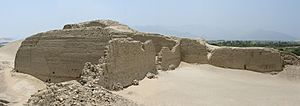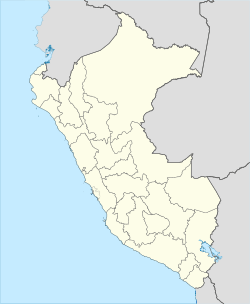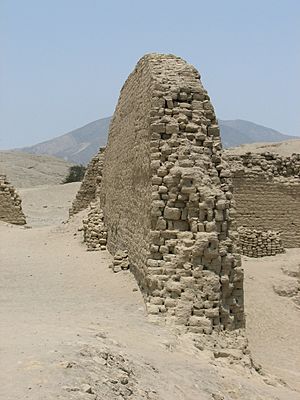Pañamarca facts for kids

Partial view of Pañamarca
|
|
| Location | Peru, Ancash Region |
|---|---|
| Coordinates | 9°12′32″S 78°22′22″W / 9.20889°S 78.37278°W |
Pañamarca is an ancient site in Peru, located in the Ancash Region. Its name might come from the Quechua language, meaning "right-hand village." You can find it in the Santa Province, near the Nepeña River.
This special place is important because it shows signs of two different ancient civilizations: the Moche culture and the Inca Empire. This means Pañamarca was a significant spot for both groups. Today, it mostly looks like old, ruined walls and sand. But archaeologists believe much more is hidden underground. Future digs could reveal more about how the city looked when it was busy and important.
Contents
Pañamarca and the Moche Culture
The Moche people lived in Pañamarca during the later part of their history, from about 600 AD until their culture ended around 700 AD. They left behind many interesting items. These artifacts help us understand what life was like for the Moche.
Ancient Shields and Weapons
Archaeologists found handmade shields at Pañamarca. These shields were woven from strong plant fibers. They looked a bit like burlap and had special designs on the front. One shield was likely left as an offering before a temple was rebuilt.
These shields were probably used in religious events or during battles. Even in war, there were special customs for how people dressed and showed their symbols. A shield was more than just a defense tool. It became a powerful symbol in Moche rituals.
Moche shields and war clubs were often shown together in their art. These "weapon bundles" were very common in Moche art, especially after 400 AD. They sometimes included spear throwers, darts, and even clothes from defeated warriors. By the late Moche period, the weapon bundle became a key symbol. The club and shield design was like a logo for the Moche. These bundles of weapons and clothes from defeated enemies showed how important the military was to the Moche way of life.
The discovery of a feathered Moche shield at Pañamarca was very exciting. It showed that even after many years of damage and looting, important treasures can still be found there.
Colorful Mural Paintings
Many important mural paintings were also found at Pañamarca. These paintings were made between about 500 and 900 AD. They show images that helped the Moche people express their religious and political beliefs.
These murals were likely inspired by designs found on smaller items, like ceramic pots or woven cloths. It's thought that local artists created these paintings, rather than teams sent from other cities. These temple paintings probably helped teach people about Moche rituals and beliefs. They showed the strong presence of the Moche culture in this southern area.
Some of the murals found at the site even show designs similar to those of the Inca. Scientists are still studying these ancient paintings. They hope to learn more about the materials used and what they can tell us about the past.
See also
 In Spanish: Pañamarca para niños
In Spanish: Pañamarca para niños



